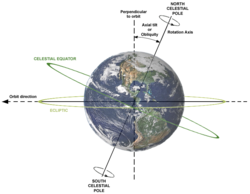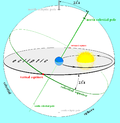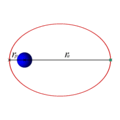Glossary of astronomy
This glossary of astronomy is a list of definitions of terms and concepts relevant to Astronomy and Cosmology. with their related fields, Astronomy is involved with the study of celestial objects and phenomena originate outside the atmosphere of Earth.
A
- A-type star
- absolute magnitude
- A measure of a
- REDIRECT Template:Glossary link internal's absolute brightness. It is defined as the
- REDIRECT Template:Glossary link internal the star would show if it were located at a distance of 10
- REDIRECT Template:Glossary link internal, or 32.6
- REDIRECT Template:Glossary link internal.
- accretion disk
- A roughly circular mass of diffuse material in orbit around a central object, such as a star or black hole. The material is acquired from a source external to the central object, and friction causes it to spiral inward towards the object.
- active galactic nucleus (AGN)
- A compact region in the center of a
- REDIRECT Template:Glossary link internal displaying a much higher than normal
- REDIRECT Template:Glossary link internal over some part of the electromagnetic spectrum with characteristics indicating that the luminosity is not produced by
- REDIRECT Template:Glossary link internal. A galaxy hosting an AGN is called an active galaxy.
- albedo
- A measure of the proportion of the total solar radiation received by an
- REDIRECT Template:Glossary link internal, such as a
- REDIRECT Template:Glossary link internal, that is diffusely reflected away from the body.
- aphelion
- The point at which a body orbiting the Earth's
- REDIRECT Template:Glossary link internal is furthest from the Sun. Contrast
- REDIRECT Template:Glossary link internal.
- apoapsis
- The point at which an orbiting body is furthest from its
- REDIRECT Template:Glossary link internal. Contrast
- REDIRECT Template:Glossary link internal.
- apogee
- The point at which a body orbiting the Earth (such as the
- REDIRECT Template:Glossary link internal or an
- REDIRECT Template:Glossary link internal) is furthest from the Earth. Contrast
- REDIRECT Template:Glossary link internal.
- apparent magnitude
- A measure of the brightness of a celestial body as seen by an observer on Earth, adjusted to the value it would have in the absence of the atmosphere. The brighter the object appears, the lower its magnitude.
- apsis
- In the
- REDIRECT Template:Glossary link internal of a
- REDIRECT Template:Glossary link internal, one of the two extreme points of distance between the body and its
- REDIRECT Template:Glossary link internal – either the point of minimal distance, called the
- REDIRECT Template:Glossary link internal, or the point of maximal distance, called the
- REDIRECT Template:Glossary link internal. The term may also be used to refer to the value of the distance rather than the point itself. All
- REDIRECT Template:Glossary link internal have exactly two apsides.
- argument of periapsis
- The angle from an
- REDIRECT Template:Glossary link internal body's
- REDIRECT Template:Glossary link internal to its
- REDIRECT Template:Glossary link internal, measured in the direction of motion. It is one of six canonical
- REDIRECT Template:Glossary link internal used to characterize an orbit.
- artificial satellite
- An object that has been intentionally placed into
- REDIRECT Template:Glossary link internal by humans, often around the Earth but also around other bodies within the
- REDIRECT Template:Glossary link internal. Contrast
- REDIRECT Template:Glossary link internal.
- ascending node
- The
- REDIRECT Template:Glossary link internal at which an orbiting object moves north through the
- REDIRECT Template:Glossary link internal (in geocentric and heliocentric orbits) or at which the orbiting object moves away from the observer (in orbits outside of the
- REDIRECT Template:Glossary link internal). The position of the ascending node with respect to a reference direction, called the
- REDIRECT Template:Glossary link internal, is used along with other
- REDIRECT Template:Glossary link internal to describe an orbit. Contrast
- REDIRECT Template:Glossary link internal.
- aspect
- The position of a
- REDIRECT Template:Glossary link internal or Earth's
- REDIRECT Template:Glossary link internal with respect to the
- REDIRECT Template:Glossary link internal, as viewed from Earth.[1]
- asteroid
- A
- REDIRECT Template:Glossary link internal of the inner
- REDIRECT Template:Glossary link internal, for example the one that orbits the
- REDIRECT Template:Glossary link internal at a distance is no greater than the orbit of Jupiter. Asteroids are somewhat arbitrarily distinguished from many different types of similar objects:
- REDIRECT Template:Glossary link internal primarily composed of dust and ice instead of mineral and rock are known as
- REDIRECT Template:Glossary link internal; bodies less than one meter in diameter are known as
- REDIRECT Template:Glossary link internal; very large asteroids are sometimes called
- REDIRECT Template:Glossary link internal or
- REDIRECT Template:Glossary link internal; and bodies similar to asteroids in size and composition but which lie beyond Jupiter are known as
- REDIRECT Template:Glossary link internal.
- asteroid belt
- The
- REDIRECT Template:Glossary link internal in the
- REDIRECT Template:Glossary link internal located roughly between the orbits of Mars and Jupiter that is occupied by numerous irregularly shaped
- REDIRECT Template:Glossary link internal ranging in size from dust particles to
- REDIRECT Template:Glossary link internal and
- REDIRECT Template:Glossary link internal. The asteroid belt is often called the main asteroid belt or main belt to distinguish it from other asteroid populations in other parts of the Solar System.
- astrobiology
- An interdisciplinary field that studies the origins, evolution, distribution, and future of living systems in the universe, encompassing research on organic compounds in
- REDIRECT Template:Glossary link internal, abiogenesis and extreme-environment adaptation on Earth, the habitability of
- REDIRECT Template:Glossary link internal, the possible existence of extraterrestrial life, and how humans might be able to detect extraterrestrial biosignatures, among other topics.
- astrodynamics
- See
- REDIRECT Template:Glossary link internal.
- astrogeology
- astrometric binary
- A type of
- REDIRECT Template:Glossary link internal where evidence for an unseen orbiting companion is revealed by its periodic
- REDIRECT Template:Glossary link internal of the visible component. See also
- REDIRECT Template:Glossary link internal.
- astrometry
- The branch of astronomy that involves precise measurements of the positions and movements of
- REDIRECT Template:Glossary link internal and other
- REDIRECT Template:Glossary link internal.
- astronomical body
- A type of naturally occurring physical entity, association, or structure within the
- REDIRECT Template:Glossary link internal that is a single, tightly bound, contiguous structure, such as a
- REDIRECT Template:Glossary link internal,
- REDIRECT Template:Glossary link internal,
- REDIRECT Template:Glossary link internal, or
- REDIRECT Template:Glossary link internal. Though the terms astronomical "body" and
- REDIRECT Template:Glossary link internal are often used interchangeably, there are technical distinctions.
- astronomical unit (AU)
- A unit of length used primarily for measuring astronomical distances within the
- REDIRECT Template:Glossary link internal or between the Earth and distant stars.
- astronomy
- The scientific study of
- REDIRECT Template:Glossary link internal and
- REDIRECT Template:Glossary link internal, the origins of those objects and phenomena, and their evolution.
- astrophysics
- The branch of astronomy that employs principles of physics and chemistry to determine the nature of
- REDIRECT Template:Glossary link internal and phenomena, examining properties such as luminosity, density, temperature, and chemical composition (rather than the positions or motions of objects in space, which is more specifically the emphasis of
- REDIRECT Template:Glossary link internal).
- axial precession
- A slow, continuous, gravity-induced change (a
- REDIRECT Template:Glossary link internal) in the orientation of an
- REDIRECT Template:Glossary link internal's
- REDIRECT Template:Glossary link internal.
- axial tilt
- The angle between an object's rotational axis and its orbital axis, or, equivalently, the angle between its
- REDIRECT Template:Glossary link internal plane and
- REDIRECT Template:Glossary link internal. Axial tilt usually does not change considerably during a single
- REDIRECT Template:Glossary link internal; Earth's axial tilt is the cause of the seasons. Axial tilt is distinct from
- REDIRECT Template:Glossary link internal.
B
- barycenter
- The common center of mass about which any two or more bodies of a gravitationally bound system
- REDIRECT Template:Glossary link internal.
- baryogenesis
- How the class of subatomic particles known as baryons were generated in the early Universe, including the means by which baryons outnumber antibaryons.
- Big Bang
- The prevailing
- REDIRECT Template:Glossary link internal for the origin of the
- REDIRECT Template:Glossary link internal. It depicts a starting condition of extremely high density and temperature, followed by an ongoing expansion that led to the current conditions.
- binary star
- A
- REDIRECT Template:Glossary link internal consisting of exactly two
- REDIRECT Template:Glossary link internal orbiting around their common
- REDIRECT Template:Glossary link internal. The term is often used interchangeably with
- REDIRECT Template:Glossary link internal, though the latter can also refer to an optical double star, a type of optical illusion which is entirely distinct from true binary star systems.
Glossary Of Astronomy Media
Syrtis Major (center) is a prominent dark
- REDIRECT Template:Glossary link internal on Mars.
Two bodies of similar mass orbit a common
- REDIRECT Template:Glossary link internal external to both, as usual in
- REDIRECT Template:Glossary link internal systems
A diagram of the relationships between the Earth's
- REDIRECT Template:Glossary link internal, its
- REDIRECT Template:Glossary link internal, and the
- REDIRECT Template:Glossary link internal around the Sun, known as the
- REDIRECT Template:Glossary link internal. Note that the Earth's rotational axis is not perpendicular to the ecliptic but rather is
- REDIRECT Template:Glossary link internal; this means that the path of the Sun, as viewed from Earth, appears to move both above and below the celestial equator during the course of the year.
Circumstellar
- REDIRECT Template:Glossary link internal as detected by the Hubble Space Telescope, and artist's impressions of the disks' orientations around their host stars
The
- REDIRECT Template:Glossary link internal (grey) is defined by the Earth's orbit around the Sun, and is distinct from the plane of the
- REDIRECT Template:Glossary link internal's
- REDIRECT Template:Glossary link internal (green), which is permanently
- REDIRECT Template:Glossary link internal 23.4 degrees with respect to the ecliptic. To an observer on Earth, this means that the path the Sun appears to follow upon the celestial sphere is not a straight line (i.e. the ecliptic does not appear "flat"). Twice during each complete orbit, at the two
- REDIRECT Template:Glossary link internal, the Sun's path appears to intersect the celestial equator, though the two planes are never in fact coplanar.
A relatively small body (such as a planet) orbiting a larger one (such as a star) in an
- REDIRECT Template:Glossary link internal, with the larger body located at one of the focal points of the ellipse
Sample
- REDIRECT Template:Glossary link internal for stars of different mass
A luminous red galaxy (LRG) acting as a
- REDIRECT Template:Glossary link internal, distorting the light from a much more distant blue galaxy into an Einstein ring
The
- REDIRECT Template:Glossary link internal are caused by the visible side of the Moon being alternately illuminated by sunlight and immersed in shadow during its orbit around the Earth.
The bright
- REDIRECT Template:Glossary link internal of the
- REDIRECT Template:Glossary link internal is visible in dark skies on clear nights, in the direction of the
- REDIRECT Template:Glossary link internal Sagittarius.
References
- ↑ Mitton, Jacqueline (2007). Cambridge Illustrated Dictionary of Astronomy. Cambridge, UK: Cambridge University Press. ISBN 978-0-521-82364-7.









